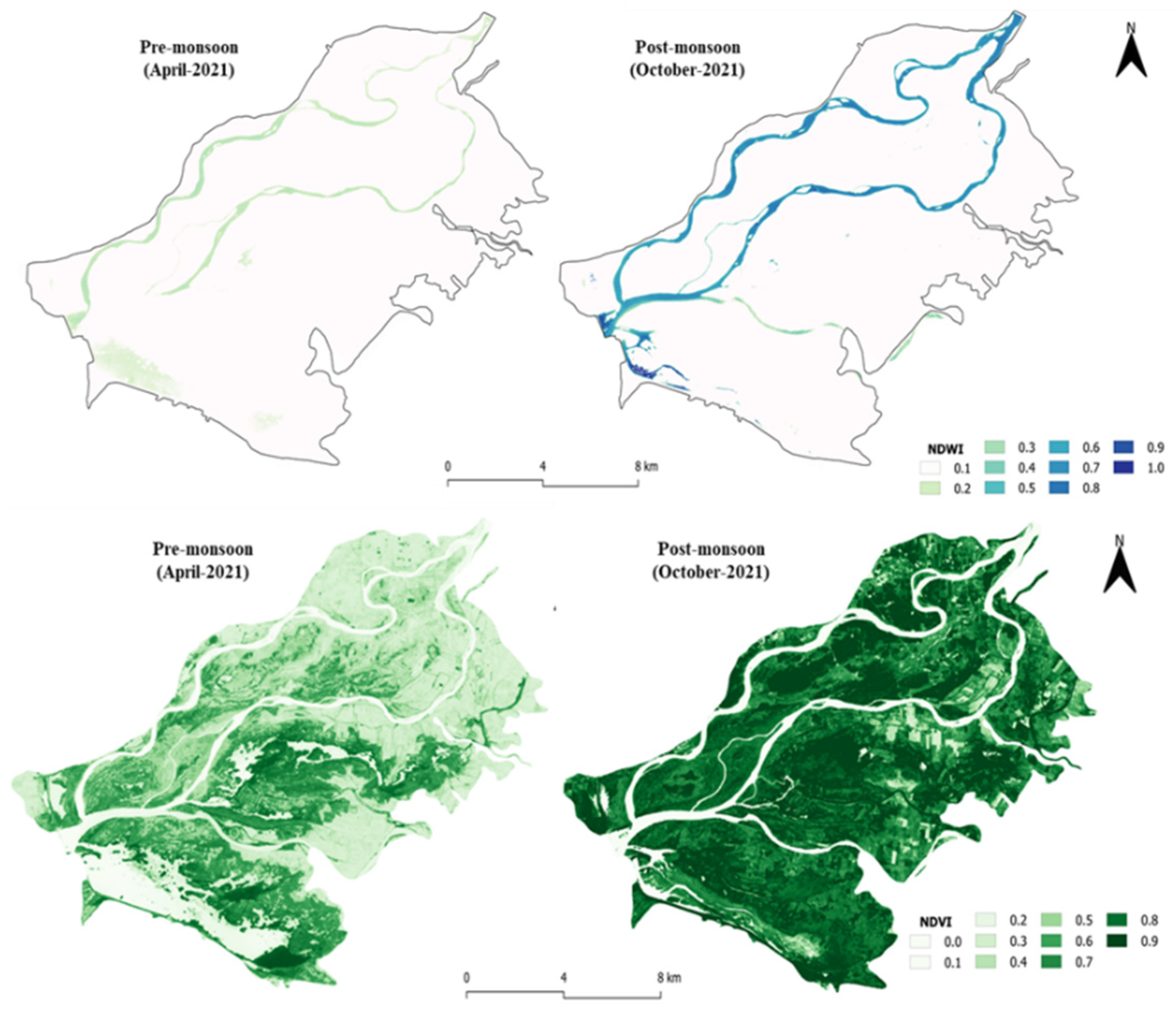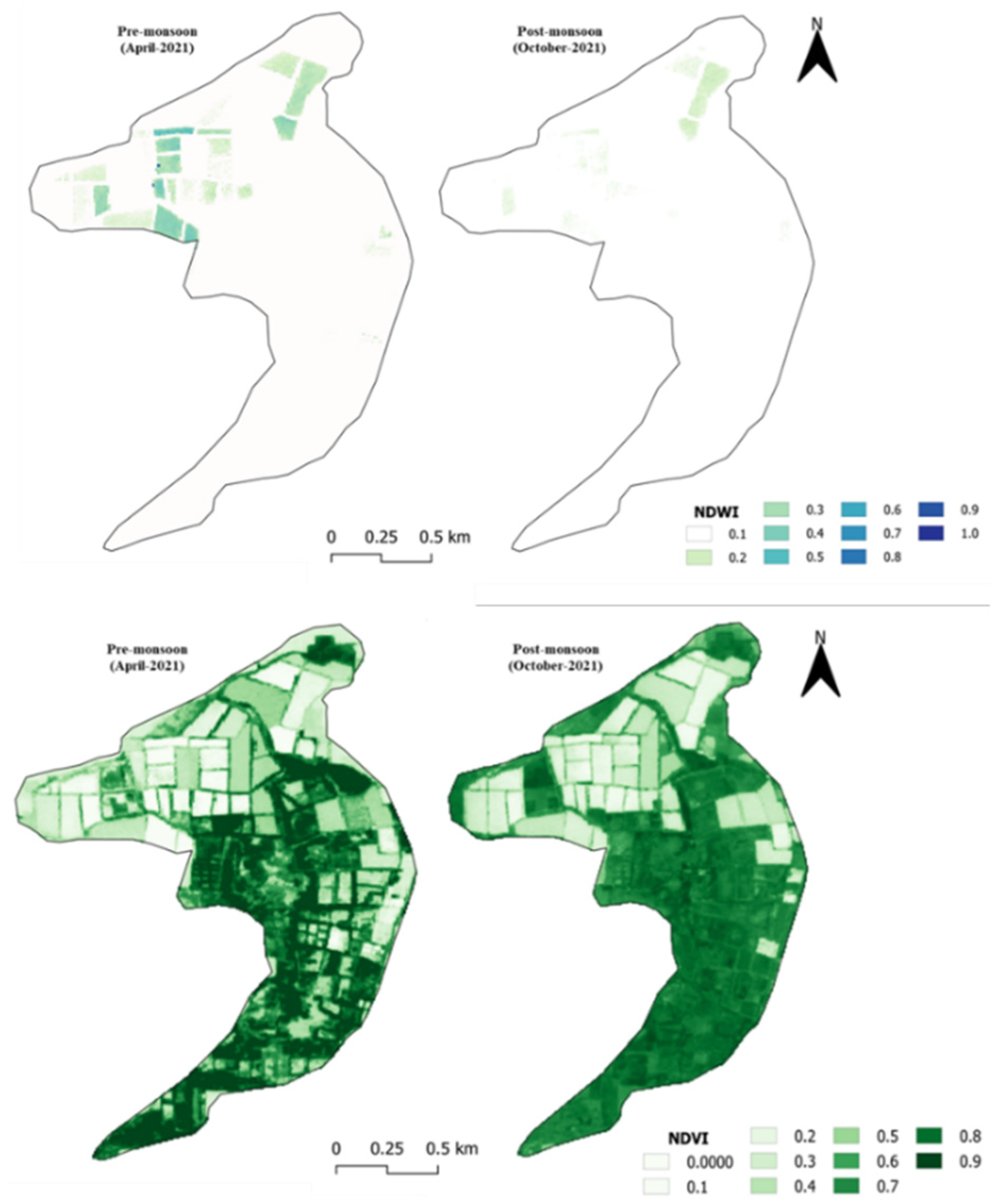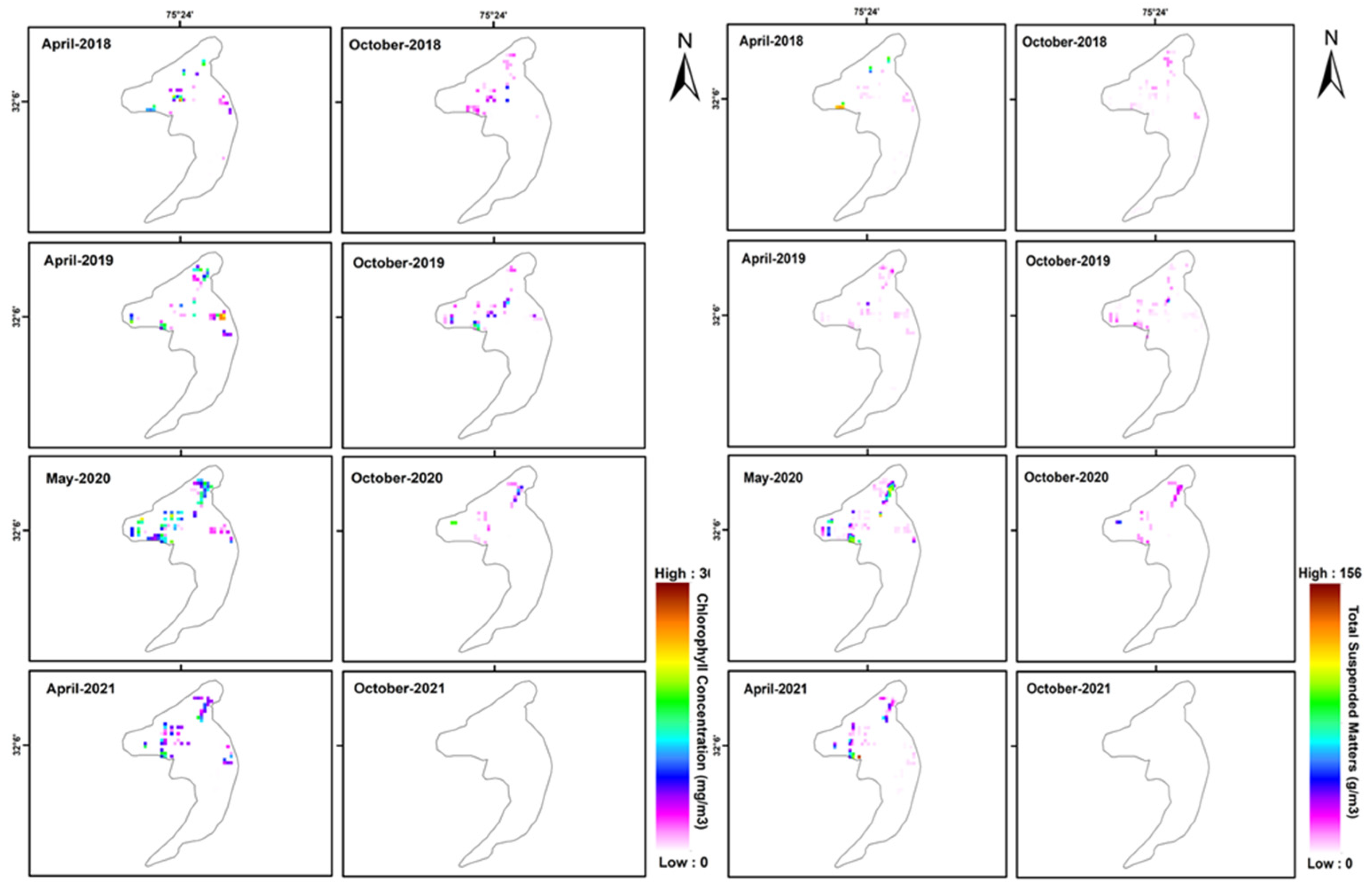Assessment and Monitoring of Optically Active Water Quality Parameters on Wetland Ecosystems Based on Remote Sensing Approach: A Case Study on Harike and Keshopur Wetland over Punjab Region, India †
Abstract
1. Introduction
2. Materials and Methods
2.1. Study Area
2.2. Data
2.3. Methods
3. Results and Discussion
4. Conclusions
Author Contributions
Funding
Institutional Review Board Statement
Informed Consent Statement
Data Availability Statement
Acknowledgments
Conflicts of Interest
References
- Carter, T.R. Assessing climate change adaptations: The IPCC guidelines. In Adapting to Climate Change; Springer: New York, NY, USA, 1996; pp. 27–43. [Google Scholar] [CrossRef]
- Sahagian, D.; Melack, J.; Birkett, C.; Chanton, J.; Dunne, T.; Estes, J.; Finlayson, M.; Fresco, L.; Gopal, B.; Hess, L.; et al. Global wetland distribution and functional characterizaton: Trace gases and the hydrologic cycle. In Proceedings of the Joint IGBP GAIM-DIS-BAHC-IGAC-LUCC Workshop, IGBP GAIM/IGBP Global Change, Santa Barbara, CA, USA, 16–20 May 1996; p. 45. [Google Scholar]
- Finlayson, C.M.; Davidson, N.C. Global Review of Wetland Resources and Priorities for Wetland Inventory; Preface iv Summary Report; Wetlands International: Wageningen, The Netherlands, 1999; p. 15. [Google Scholar]
- Ferrati, R.; Canziani, G.A.; Moreno, D.R. Esteros del Ibera: Hydrometeorological and hydrological characterization. Ecol. Model. 2005, 186, 3–15. [Google Scholar] [CrossRef]
- Junk, W.J.; An, S.; Finlayson, C.M.; Gopal, B.; Květ, J.; Mitchell, S.A.; Mitsch, W.J.; Robarts, R.D. Current state of knowledge regarding the world’s wetlands and their future under global climate change: A synthesis. Aquat. Sci. 2013, 75, 151–167. [Google Scholar] [CrossRef]
- Barros, D.F.; Albernaz, A.L. Possible impacts of climate change on wetlands and its biota in the Brazilian Amazon. Braz. J. Biol. 2014, 74, 810–820. [Google Scholar] [CrossRef] [PubMed]
- Singh, S.; Chakraborty, S. Performance of organic substrate amended constructed wetland treating acid mine drainage (AMD) of North-Eastern India. J. Hazard. Mater. 2020, 397, 122719. [Google Scholar] [CrossRef] [PubMed]
- Klemas, V. Remote sensing of wetlands: Case studies comparing practical techniques. J. Coast. Res. 2011, 27, 418–427. [Google Scholar]
- Sivakumar, R.; Ghosh, S. Wetland spatial dynamics and mitigation study: An integrated remote sensing and GIS approach. Nat. Hazards 2016, 80, 975–995. [Google Scholar] [CrossRef]
- Kundapura, S.; Kommoju, R.; Verma, I. Assessment of changes in wetland storage in Gurupura River Basin of Karnataka, India, using remote sensing and GIS techniques. InWater Resources and Environmental Engineering II; Springer: Singapore, 2019; pp. 57–68. [Google Scholar]
- Erwin, K.L. Wetlands and global climate change: The role of wetland restoration in a changing world. Wetl. Ecol. Manag. 2009, 17, 71–84. [Google Scholar] [CrossRef]
- Hulme, P.E. Adapting to climate change: Is there scope for ecological management in the face of a global threat? J. Appl. Ecol. 2005, 42, 784–794. [Google Scholar] [CrossRef]
- Solomon, S. IPCC (2007): Climate change the physical science basis. In Proceedings of the AGU Fall Meeting Abstracts, San Francisco, CA, USA, 10–14 December 2007; Volume 2007, p. U43D-01. [Google Scholar]
- Prasad, S.N.; Ramachandra, T.V.; Ahalya, N.; Sengupta, T.; Kumar, A.; Tiwari, A.K.; Vijayan, V.S.; Vijayan, L. Conservation of wetlands of India-a review. Trop. Ecol. 2002, 43, 173–186. [Google Scholar]
- Bassi, N.; Kumar, M.D.; Sharma, A.; Pardha-Saradhi, P. Status of wetlands in India: A review of extent, ecosystem benefits, threats and management strategies. J. Hydrol. Reg. Stud. 2014, 2, 1–19. [Google Scholar] [CrossRef]
- Sharma, S.; Nagpal, A.K.; Kaur, I. Heavy metal contamination in soil, food crops and associated health risks for residents of Ropar wetland, Punjab, India and its environs. Food Chem. 2018, 255, 15–22. [Google Scholar] [CrossRef] [PubMed]
- Li, L.; Geng, S.; Wu, C.; Song, K.; Sun, F.; Visvanathan, C.; Xie, F.; Wang, Q. Microplastics contamination in different trophic state lakes along the middle and lower reaches of Yangtze River Basin. Environ. Pollut. 2019, 254, 112951. [Google Scholar] [CrossRef] [PubMed]
- Kumar, M.D.; Shah, Z.; Mukherjee, S.; Mudgerikar, A. Water, human development and economic growth: Some international perspectives. In Proceedings of the IWMI-Tata Water Policy Research Program’s Seventh Annual Partners’ Meet, ICRISAT, Hyderabad, India, 2 April 2008. [Google Scholar]
- Palmer, S.C.; Kutser, T.; Hunter, P.D. Remote sensing of inland waters: Challenges, progress and future directions. Remote Sens. Environ. 2015, 157, 1–8. [Google Scholar] [CrossRef]
- Garg, V.; Eslamian, S. Monitoring, assessment, and forecasting of drought using remote sensing and the geographical information system. In Handbook of Drought and Water Scarcity; CRC Press: Boca Raton, FL, USA, 2017; pp. 217–252. [Google Scholar]
- Bonansea, M.; Ledesma, M.; Rodriguez, C.; Pinotti, L. Using new remote sensing satellites for assessing water quality in a reservoir. Hydrol. Sci. J. 2019, 64, 34–44. [Google Scholar] [CrossRef]
- Giardino, C.; Brando, V.E.; Dekker, A.G.; Strömbeck, N.; Candiani, G. Assessment of water quality in Lake Garda (Italy) using Hyperion. Remote Sens. Environ. 2007, 109, 183–195. [Google Scholar] [CrossRef]
- Sharma, R.; Patel, S.; Litoria, P.K.; Pateriya, B. Changes in river channel dynamics of the Satluj river, Punjab: Using a geospatial approach. J. Geol. Soc. India 2022, 98, 1283–1289. [Google Scholar] [CrossRef]
- Setia, R.; Dhaliwal, S.S.; Kumar, V.; Singh, R.; Kukal, S.S.; Pateriya, B. Impact assessment of metal contamination in surface water of Sutlej River (India) on human health risks. Environ. Pollut. 2020, 265, 114907. [Google Scholar] [CrossRef]
- Alamdar, R.; Kumar, V.; Moghtaderi, T.; Naghibi, S.J. Groundwater quality evaluation of Shiraz City, Iran using multivariate and geostatistical techniques. SN Appl. Sci. 2019, 1, 1367. [Google Scholar] [CrossRef]
- Gitelson, A. The peak near 700 nm on radiance spectra of algae and water: Relationships of its magnitude and position with chlorophyll concentration. Int. J. Remote Sens. 1992, 13, 3367–3373. [Google Scholar] [CrossRef]
- Kirk, J.T. Light and Photosynthesis in Aquatic Ecosystems; Cambridge University Press: Cambridge, UK, 1994. [Google Scholar]
- Mobley, C.D. Light and Water: Radiative Transfer in Natural Waters; Academic Press: San Francisco, CA, USA, 1994. [Google Scholar]
- Dihkan, M.; Karsli, F.; Guneroglu, A. Mapping total suspended matter concentrations in the Black Sea using Landsat TM multispectral satellite imagery. Fresenius Environ. Bull. 2011, 20, 262–269. [Google Scholar]
- Zheng, Z.; Li, Y.; Guo, Y.; Xu, Y.; Liu, G.; Du, C. Landsat-based long-term monitoring of total suspended matter concentration pattern change in the wet season for Dongting Lake, China. Remote Sens. 2015, 7, 13975–13999. [Google Scholar] [CrossRef]





| Seasons | Date of Acquired Data | Chlorophyll Concentration Range (mg/m3) | Total Suspended Matter (g/m3) | Chlorophyll Concentration Range (mg/m3) | Total Suspended Matter (g/m3) |
|---|---|---|---|---|---|
| Harike | Keshopur | ||||
| Pre-Monsoon | 18-Apr-18 | 0.01–28.21 | 0.08–77.86 | 0.09–31.46 | 0.16–126.74 |
| 23-Apr-19 | 0.01–27.66 | 0.08–126.49 | 0.03–29.94 | 0.12–34.07 | |
| 22-May-20 | 0.01–36.31 | 0.08–140.01 | 0.06–25.74 | 0.27–121.46 | |
| 12-Apr-21 | 0.01–25.92 | 0.09–57.19 | 0.02–19.83 | 0.12–143.89 | |
| Post-Monsoon | 05-Oct-18 | 0.01–28.57 | 0.03–149.01 | 0.01–10.93 | 0.03–13.35 |
| 10-Oct-19 | 0.01–32.20 | 0.02–145.54 | 0.02–18.78 | 0.03–60.44 | |
| 09-Oct-20 | 0.01–29.52 | 0.06–141.82 | 0.03–20.98 | 0.13–49.35 | |
| 09-Oct-21 | 0.02–26.31 | 0.03–136.00 | Nil | Nil |
Publisher’s Note: MDPI stays neutral with regard to jurisdictional claims in published maps and institutional affiliations. |
© 2022 by the authors. Licensee MDPI, Basel, Switzerland. This article is an open access article distributed under the terms and conditions of the Creative Commons Attribution (CC BY) license (https://creativecommons.org/licenses/by/4.0/).
Share and Cite
Arora, M.; Mudaliar, A.; Pateriya, B. Assessment and Monitoring of Optically Active Water Quality Parameters on Wetland Ecosystems Based on Remote Sensing Approach: A Case Study on Harike and Keshopur Wetland over Punjab Region, India. Eng. Proc. 2022, 27, 84. https://doi.org/10.3390/ecsa-9-13361
Arora M, Mudaliar A, Pateriya B. Assessment and Monitoring of Optically Active Water Quality Parameters on Wetland Ecosystems Based on Remote Sensing Approach: A Case Study on Harike and Keshopur Wetland over Punjab Region, India. Engineering Proceedings. 2022; 27(1):84. https://doi.org/10.3390/ecsa-9-13361
Chicago/Turabian StyleArora, Mohit, Ashwini Mudaliar, and Brijendra Pateriya. 2022. "Assessment and Monitoring of Optically Active Water Quality Parameters on Wetland Ecosystems Based on Remote Sensing Approach: A Case Study on Harike and Keshopur Wetland over Punjab Region, India" Engineering Proceedings 27, no. 1: 84. https://doi.org/10.3390/ecsa-9-13361
APA StyleArora, M., Mudaliar, A., & Pateriya, B. (2022). Assessment and Monitoring of Optically Active Water Quality Parameters on Wetland Ecosystems Based on Remote Sensing Approach: A Case Study on Harike and Keshopur Wetland over Punjab Region, India. Engineering Proceedings, 27(1), 84. https://doi.org/10.3390/ecsa-9-13361






